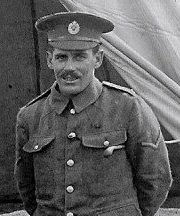
7058
Lance Corporal
JAMES FREDERICK HAIN
Royal Engineers
by
Lieutenant Colonel (Retired)
Edward De Santis, MSCE, P.E., MinstRE
U.S. Army Corps of
Engineers
(June 2023)

Figure 1. 7058 Lance Corporal
James Frederick Hain, R.E.
(Image courtesy of Betty Swain)
1. INTRODUCTION
The primary source of information for this research was obtained from the Hain family tree which was found on Ancestry.com. The extensive family tree was the work of Betty Swain of Wendron, Cornwall, the granddaughter of James Hain, who has done a remarkable job providing genealogical information and images dealing with the Hain family. The sources of information included in this narrative are shown in the REFERENCE section of this work. Where no source for any information is cited, the reader may assume that the source was either the Hain family tree or Lance Corporal Hain’s military service papers.
This narrative is meant to deal primarily with Hain’s military service. His service in the Army was rather unique due to the time he spent on active service and the many transfers he made to different classes of the Army Reserve. Where his service papers were used as reference, some errors regarding dates and locations may exist as many of the entries in those papers were handwritten, some in pencil, and the writing has faded with time. Every effort has been made to provide an accurate account of his service during the South African War, 1899-1902, and the Great War of 1914-1918.
2. FAMILY INFORMATION
James Frederick Hain was born on 5 November 1881 in the Parish of Holmer near the Town of Hereford in the County of Herefordshire. He was the son of James Hain (1848-1907), a manure agent, and Catherine Margaret Hain, née Preece (1854-1935).
James worked as a French Polisher prior to his enlistment in the Army in 1900. As a French Polisher he used his skills to treat wood and restore furniture and items like staircases, doors and musical instruments. French polishing is a wood finishing technique that results in a very high gloss surface, with a deep colour and chatoyancy.[1] The process consists of applying many thin coats of shellac dissolved in denatured alcohol using a rubbing pad lubricated with one of a variety of oils.[2]
3. PHYSICAL DESCRIPTION
The following is a physical description of Hain at the time of his enlistment in the Army in September of 1900. The information was taken from his Description on Enlistment, a form included in his service papers during a medical examination at Dalston in East London.
Age: |
18 years and 10 months |
Height: |
5 feet 6 inches |
Weight: |
119 pounds |
Chest (expanded): |
35 inches |
Chest (normal): |
32½ inches |
Complexion: |
Fresh |
Eyes: |
Hazel |
Hair: |
Brown |
Distinctive marks: |
Anchor and dots on left forearm |
Religion: |
Church of England[3] |
4. RECRUITMENT, ENLISTMENT AND TRAINING
Recruitment
James Hain was initially recruited in the London Recruiting District for service in the Royal Berkshire Regiment. He was recruited by a Pensioner, one Sergeant O’Donnell, who probably was a retired non-commissioned officer of the regiment. At the time that he was recruited the Hain family was living on Roscoe Street in the St. Luke’s area of London where, at that time, his father ran a coffee house.
Enlistment
At the time of his Attestation on 5 September 1900 Hain provided his place of birth, his age and his trade in civil life. He also indicated that he was a British Subject and that he had not resided out of his father’s house prior to his enlistment. He then indicated that he was not married and was not and never had been an Apprentice and that he had never been imprisoned by Civil Power. He further stated that he was not currently a member of Her Majesty’s naval or military forces, that he had never previously served and that he had never been rejected for service. He further indicated that he was willing to enlist in the Royal Berkshire Regiment.[4]
Based on the results of his medical examination, Hain was judged to be fit for service in the Army. The Recruiting Officer found him to be a “Fair” recruit[5] and fit for service in the Royal Berkshire Regiment. His Attestation was approved on the same day as his enlistment and he was assigned Regimental Number 5988 as a Private in the Royal Berkshire Regiment.
Training
On 7 September 1900 Hain reported to the depot of the Princess Charlotte of Wales’s (Royal Berkshire Regiment) at Reading and on 20 November 1900 he was transferred to the Corps of Royal Engineers as a Sapper, Regimental Number 7058. Just why and how this transfer came about is not explained in his military records. The Royal Engineers might have been short on new recruits at the time and/or Hain’s civil trade might have been considered useful to the Corps.
Following his transfer Hain was sent off for recruit training at the School of Military Engineering at Chatham, Kent. With the exception of Drivers, every recruit enlisted for the Royal Engineers had to have a trade. Pioneers and Sappers were sent to Chatham where they were trained in infantry drill and pioneer duties. The engineer recruits also received musketry training. When the course of training was completed the recruits had to pass an examination and were then transferred to engineer formations, where they received higher pay and could earn extra allowances by working at their special trades.
5. POSTINGS, ASSIGNMENTS AND CAMPAIGN SERVICEAldershot (1900-1901)
After about four months of training at Chatham, Hain was sent to Aldershot, Hampshire on 31 March 1901 where he was posted as a Sapper to the newly raised “D” Pontoon Troop of the Bridge Battalion, Royal Engineers at Stanhope and Wellington Lines.[6] After about five weeks of training at Aldershot he was rated “Very Good” as a Pontonier, 6th Class.
South Africa (1901-1902)
Following six more months of bridging training at Aldershot, Sapper Hain departed for South Africa on 16 November 1901, arriving there in early December where he was posted to “A” Pontoon Troop of the Bridging Battalion. “A” Pontoon Troop had been at Aldershot prior to Hain’s arrival there, but when the Boers declared war in South Africa in October 1899 that unit was dispatched to the Cape Colony along with the Army Corps and it formed part of the Natal Field Force. The troop spent the war assisting British infantry, artillery and cavalry units in crossing a number of rivers in the war zone by constructing pontoon bridges like the one shown below. Sapper Hain remained with the troop until the end of October when he departed South Africa, arriving in England on 1 November 1902.
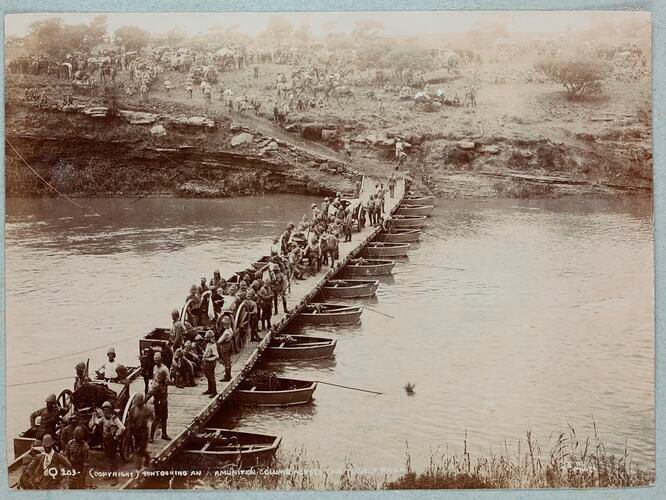
Figure
2. A Pontoon Bridge Constructed by the Royal Engineers in South
Africa.
(Image courtesy of Wikipedia)
Chatham (1902-1904)
Upon his arrival home he was posted to the School of Military Engineering at Chatham. It is unclear from his service papers whether he was posted as a student, for administrative work or on the teaching staff. His records do show that he passed a class of instruction in swimming in January 1904 and that on 30 March 1904 he extended to complete 8 years of service with the Colours.[7]
Aldershot (1904-1906)
Again, Hain’s service papers are unclear with regard to the unit that he served in at Aldershot. It is likely that his posting was to a bridging unit or perhaps to a signals unit. As Aldershot was known as the “Home of the British Army” there were many units of the Royal Engineers stationed there. During the time that Hain was serving at Aldershot, the following units of the Royal Engineers were present there:
· 7th Field Company
· 17th Field Company
· 23rd Field Company
· 3 Divisions of the Telegraph Battalion
· 3 Troops of the Bridging Battalion
· 1st Field Troop
· 3rd Field Troop
· R.E. Field Depot consisting of four Field Park Troops
· Balloon Depot with five Balloon Sections
The Bridging Battalion and the Telegraph Battalion are distinct possibilities due to his prior service as a Pontonier in South Africa and the unit to which he would be posted in Limerick, however his service papers are not specific in this regard.
On 1 April 1904 Hain was granted Service Pay, Class I. Service Pay, in addition to their regular pay, was granted to men in the Royal Engineers who demonstrated proficiency in their military trades. Service Pay was awarded in seven classes, with Class I being the highest. On 21 December 1904 Hain received his Queen’s South Africa Medal with five clasps: [CAPE COLONY][ORANGE FREE STATE][TRANSVAAL][SOUTH AFRICA 1901] and [SOUTH AFRICA 1902]. The first three State clasps were issued to almost all soldiers who served in South Africa and the dated clasps indicate general service throughout the area of the war. These were the clasps commonly awarded to men who served in “A” Pontoon Troop; that is, most if not all men in this unit did not receive any clasps for specific battles or campaigns.
On 5 September 1905 Hain was granted a monetary increase in his Service Pay, Class I and on the same date he was awarded Good Conduct Pay at the rate of 2 pence per day. His first award of Good Conduct Pay (1 pence per day) had been awarded in South Africa on 5 September 1902.
Hain was rated as a “Fair” Painter, 5th Class on 3 October 1906. This is an interesting entry in his service papers. Up to this point in his military service his papers show that his previous Trade rating was as a Pontonier. Presumably when he was posted to Aldershot, the unit to which he was assigned made use of Painters, a recognized military Trade in the Corps of Royal Engineers. This unit may have been a field company, although his records do not reflect this. His civil trade as a French Polisher may have led to his appointment as a Painter, although these trades are only very loosely connected. A French Polisher did “stain” and “varnish” wood, whereas a Painter simply applied paint to wooden surfaces for the purpose of preservation. One wonders if he could do the more delicate work in treating and restoring wood for furniture, why was he only rated as a “Fair” Painter.
Limerick (1906-1908)
Based on a postcard in the possession his granddaughter, it is known that Hain was serving in Limerick, Ireland in the summer of 1907.
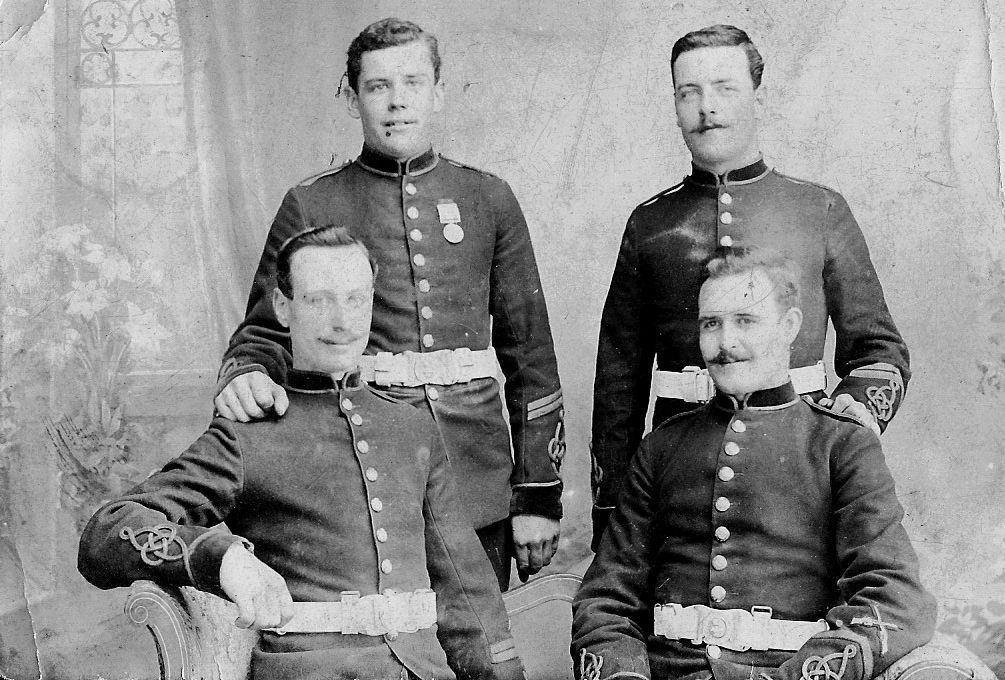
Figure
3. Sapper James Frederick Hain and Three Mates in
Limerick.
(Image
courtesy of Betty Swain)
The postcard photograph above shows Hain and three other Sappers in their No. 1 Pattern Dress uniform. Hain (standing, left) has two Long Service chevrons on his left sleeve and is wearing his Queen’s South Africa medal. This photograph of a young, 25-year old Sapper Hain shows him to be clean-shaven with a short haircut parted on the left. His appearance is much changed over the next seven years, when at the time of the start of the Great War of 1914-1918 he is sporting a “chevron” style mustache and much longer hair parted in the middle.
James sent this postcard from Limerick on 10 July 1907 to his brother William. The message on the postcard reads:
Dear Bill
Received the papers safe this morning thanks very much. This photo is the result of the King’s birthday.
Fred
Obviously the men are wearing their No. 1 Dress uniform for a parade in honour of the birthday of H.M. King Edward VII. It is also interesting to note that Hain used his middle name “Fred” when dealing with friends and family.
On his Military History Sheet in his service papers, Hain lists his “Elder Brother William Hain Rl Engineers (Balloon Section) as his next of kin. William Uriah Hain (1877-1951) was born in Herefordshire on 3 February 1877. Except for the notation in James’s service papers regarding his brother’s military service, no further information was uncovered about William’s service with an R.E. Balloon Section.

Figure
4. William Uriah Hain.
(Image
courtesy of Betty Swain)
There is an entry in Hain’s service papers dated 6 August 1907 indicating that he had demonstrated proficiency in the maintenance of field air-lines. An air-line was the name given to telegraph lines that were installed on the battlefield above the ground level to prevent them from being cut or damaged by men, animals, wagons or artillery pieces passing over them. Air-lines were installed by men serving in Royal Engineers signals units, so it is safe to assume that Hain was serving in such a unit. There were two R.E. signals units at Limerick about the time that Hain served there. They were “B” Signal Company and the 6th Signal Company. However, his service papers contain a Qualification Sheet for a Telegraphist that indicates that he was a Wiremen in “K” Telegraph Company, R.E. from 30 November 1907 to 28 February 1908. The same sheet indicates that he was in Limerick from 29 February 1908.
Between 4 July 1907 and 25 February 1908 Sapper Hain’s proficiency in 24 communications-related tasks were evaluated for his Trade and Special Qualifications. The evaluations were performed by the office of the Commander Royal Engineers (C.R.E.) Fermoy, Ireland. The results of these evaluations are shown in Annex A of this narrative. Oddly enough on 18 August 1907 he was again rated as a Painter, only this time he received a rating of “Skilled.” Despite his demonstrated proficiency in all the areas indicated in Annex A, on 1 November 1907 his Service Pay was reduced from Class I to Class II, resulting in a cut in pay.
On 29 February 1908, while employed as a Lineman for the C.R.E. Fermoy, Hain was injured on duty. In a Report on Wounds or other Injuries his commanding officer certified that “the injury . . . occurred while he was in the performance of military duty,” stating that:
On 29 February /08, the soldier was proceeding “on duty,” on transfer from Plymouth to Limerick; and owing to bad weather on boat between Fishguard and Waterford he was thrown violently forward striking his head against a girder. The soldier was in no way to blame.
Hain was admitted to hospital on 8 March 1908 suffering from a wound to his scalp. The injury was considered to be of a slight nature and would not interfere with his future efficiency as a soldier.
Army Reserve (1908-1914)
On 22 August 1908 Hain applied to re-engage with the Army Reserve at Chatham to serve a further year beginning on 5 September. In preparation for his release from active service he was given a medical examination at Limerick, which described him as follows:
Age: |
26 years and 10 months |
Height: |
5 feet 8 inches |
Chest (expanded): |
38½ inches |
Waist: |
34 inches |
Complexion: |
Fresh |
Eyes: |
Hazel |
Hair: |
Brown |
Descriptive marks: |
Anchor and dots on left forearm |
Included with the documentation transferring him to the Army Reserve was his helmet size (22) and his boot size (9-2). His trade was noted to be French Polisher and his intended place of residence was 8 Catherine Street in Plymouth, Devonshire. His home service as of 4 September 1908 was 5 years and 308 days and his total service as of that date was exactly 8 years.
James Frederick Hain was transferred to the 1st Class Army Reserve, Section A on 5 September 1908. Section A was for men who had completed their service in the regular army and who undertook to rejoin, if required, in an emergency that did not require general mobilization. A man could serve no more than two years in Section A. Pay was 7 shillings a week in addition to the reservists earnings as a civilian. He had to attend twelve training days per year.[8]
At the time of his transfer his commanding officer provided the following comments with regard to his service:
· Conduct: Exemplary
· No offenses during eight years of service
· Thoroughly sober and honest
· Accustomed to care of horses
· A Marksman
· Trade or employment in civil life: Lineman for the General Post Office, or Telegraphist in the Plymouth District
· Other trade in civil life: French Polisher
· In possession of two Good Conduct Badges
· In possession of the Queen’s South Africa medal.
On 1 September 1909 Hain re-engaged at Bodwin, Cornwall to serve in the Army Reserve, Section B. This section was the most common form of Army Reserve service for men who had completed their service in the regular army and were serving their normal period (typically of five years) on reserve. Section B reservists could only be called upon in the event of general mobilization. Pay was 3 shillings and 6 pence a week.[9]
On 13 September 1910 Hain was mobilized for Home Service to participate in training. He was called up for service with the 2nd Divisional Telegraph Company. His Army Reserve service up to this point was 2 years and 8 days. After completing the 15-day training mobilization he was released from training on 27 September and he returned to his Section B status. In April 1911 his residence was 32 Penpol Terrace, Hayle, Cornwall.
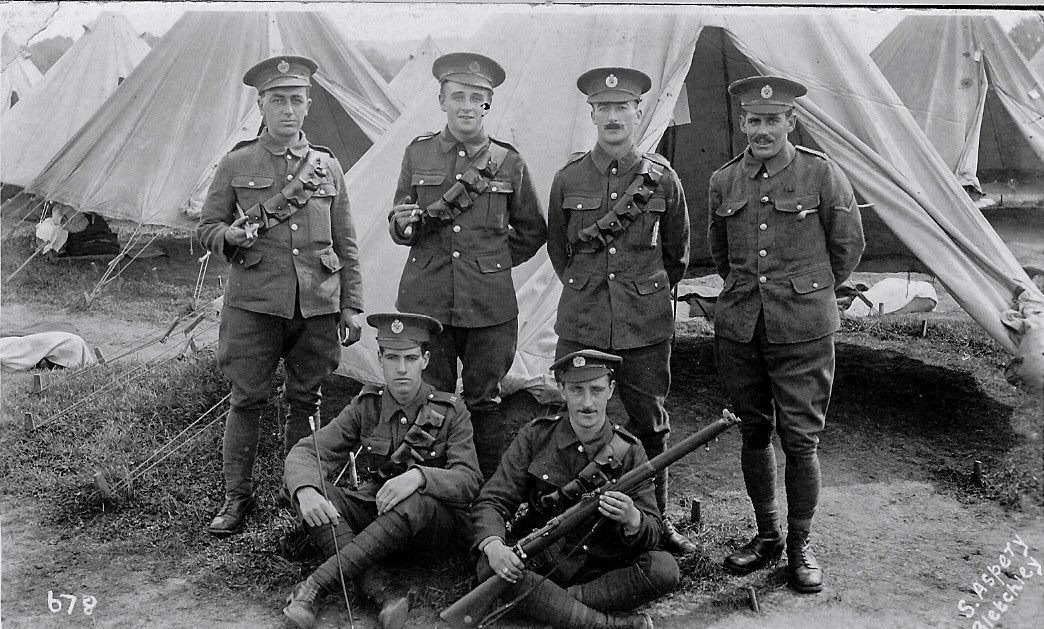
Figure
5. Lance Corporal Hain (right) and Five Other Men of
the 2nd Divisional Telegraph Company.
(Image courtesy of Betty Swain)
NOTE: The postcard photograph above appears to have been taken during a training exercise in the U.K. prior to the Great War. It may well have been taken during the 15-day training mobilization described above. Hain is wearing the single chevron of a Lance Corporal, but it may have been only an “acting” rank for the duration of the training exercise, as his service papers still indicate that he was a Sapper almost to the end of his service in the Army.
Hain applied to transfer to Section D of the Army Reserve on 5 July 1912. Section D was for men who had completed their time in Section B Reserve. In Section D he would commit for four years. This Section of the Reserve was for men who had been discharged. They had up to six months to re-engage in this form of Reserve. Terms, pay (at 6d per day, paid quarterly in arrears) and training was the same as Section B.[10] At the time of this application he resided at 3 Catharine Street in Plymouth.
On 4 September 1912 Hain finally was discharged as a Sapper in the Royal Engineers on the termination of his first period of engagement, but on 7 October 1912 he remustered in Section D as a Telegraph Linesman. His total Army Reserve Service up to this point was 1 year and 342 days and during this period it appears that he worked for the General Post Office at various locations. In March of 1913 he was living in Totnes, Devonshire, having moved from Plymouth probably to take another position with the GPO. Then on 3 February 1914 he was appointed to permanent employment in the engineering department of the GPO, but this employment would last only six months.
France (1914-1915)
The Great War broke out on 4 August 1918 and on the following day Hain was mobilized for service. On 13 August he went to France with the British Expeditionary Force (B.E.F.) and joined the Second Army Signal Company as a Field Line Telegraphist. His company was responsible for establishing communications between Second Army headquarters and the headquarters of III Corps and IV Corps under the control of the Second Army. Second Army was under the command of General Sir Horace Smith-Dorrien. With a mission as stated above, it may be assumed that the Second Army Signal Company was always in close proximity to the Army HQ in the field.
Figure
6. General Sir Horace Smith-Dorrien |
|
(Images courtesy of the National Portrait Gallery
|
|
By 26 December 1914 Hain and his company were at Bailleul and by 2 January 1915 they had moved to Hazebrouck. The Second Army’s first major engagement was the Second Battle of Ypres between April and May 1915. During this battle Hain and his company were headquartered near Chateau de Jardin at Oxelaere on 6 May. On 7 May General Sir Herbert Plumer assumed command of the Second Army.
On 8 September 1915 Hain was granted “Skilled” Engineer Pay as a Telegraphist – Field Line, thereby earning an additional 1 shilling and 4 pence per day in addition to his regular pay. Sometime during his service in France he was promoted to the rank of Lance Corporal.[11]
|
Figure 8. Hain (standing) and Another Wounded Soldier in Hospital. (Image courtesy of Betty Swain)
On 23 October 1915 the Second Army and its Signal Company was at Cassel. Hain is reported to have suffered from shell-shock on this date. He may have been at or near the Army HQ when it received sporadic shell fire, or as a Field Telegraphist and Linesman he may have been at some location between the Army HQ and one of the Corps headquarters. Just how he became a shell-shock casualty is not known, but he did suffer injury to the extent that he was evacuated to hospital in the U.K. on 30 October.
|
Following his recovery from his injury Lance Corporal Hain was posted to the Royal Engineers Signals Training School and Wireless Depot at Fenny Stratford in Buckinghamshire where he served until 14 December 1916 when he was transferred to the Class W Army Reserve. His transfer document indicated that he was suffering from neuritis, aggravated by shock and exposure. His conduct was described as “satisfactory in all respects while serving with the Colours.” As a member of the Class W Reserve he received no pay or emoluments from army funds and could not be called upon to wear a uniform or be under any military discipline; however, he did remain liable to be recalled for military service at any time. Army Order 203/16, which defined Class W, stated that this class of Reserve was for “all soldiers whose services are deemed to be more valuable to the country in civil than in military employment.”
Hain was discharged from the Army at Fenny Stratford on 3 January 1917 with his record showing that he was not in possession of any Certificates of Education[12] and his character was rated as “Very Good.” But he was not quite through with the Army.
By 3 April 1917 Hain was visiting his brother William at 2 Windsor Terrace in South Farnborough, Hampshire. At the time James was working as a Linesman and was living at Mount Pleasant in Hayle in west Cornwall.
On 9 September 1917 he appeared before an Army Medical Board at Falmouth. The proceedings of the board show that he was a Lance Corporal at that time. The board recommended that he be transferred to the Class P Army Reserve. The Class P Army Reserve was for men fit for military service in a medical category not lower than C3[13] whose services were “deemed to be temporarily of greater value to the country in civil life than in the army but who, as a result of having served in the Army, have contracted disabilities which would, if they were discharged, have rendered them eligible for consideration for a disability pension, or who are qualified by length of service to receive a pension.”
On 1 April 1918 Hain was transferred to the Class P Army Reserve with the rank of Lance Corporal. He was considered to be no longer physically fit for war service. His total service as of this date was 12 years and 51 days.
The following sections are presented in tabular form to summarize Hain’s promotions, appointments, and the medals that he was awarded during his time in the Army. They are provided to give the reader easy access to these aspects of his military service. The tables are followed by sections dealing with his marriage, personal information and post-service life.
6. PROMOTIONS AND APPOINTMENTS
Promotions: Hain received the following promotions during his time in service:
Date of Promotion or Appointment |
|
5 September 1900 |
Private, on enlistment in the Royal Berkshire Regiment. |
20 November 1900 |
Sapper, on transfer to the Royal Engineers. |
1914-1915 |
Promoted to Lance Corporal. |
Appointments: Hain received the following appointments during his time in service:
Approximate
|
|
31 March 1901 |
Pontonier |
3 October 1906 |
Painter |
30 November 1907 |
Wireman |
29 February 1908 |
Linesman |
7 October 1912 |
Telegraph Linesman |
8 September 1915 |
Telegraphist – Field Line |
7. MEDALS, AWARDS AND DECORATIONS
Hain received the following medals for his service in the South African War, 1899-1902 and the Great War of 1914-1918:
Queen’s South Africa Medal
With clasps [CAPE COLONY][ORANGE FREE STATE][TRANSVAAL]
[SOUTH AFRICA 1901][SOUTH AFRICA 1902]
1914 Star
British War Medal
Victory Medal
Silver War Badge
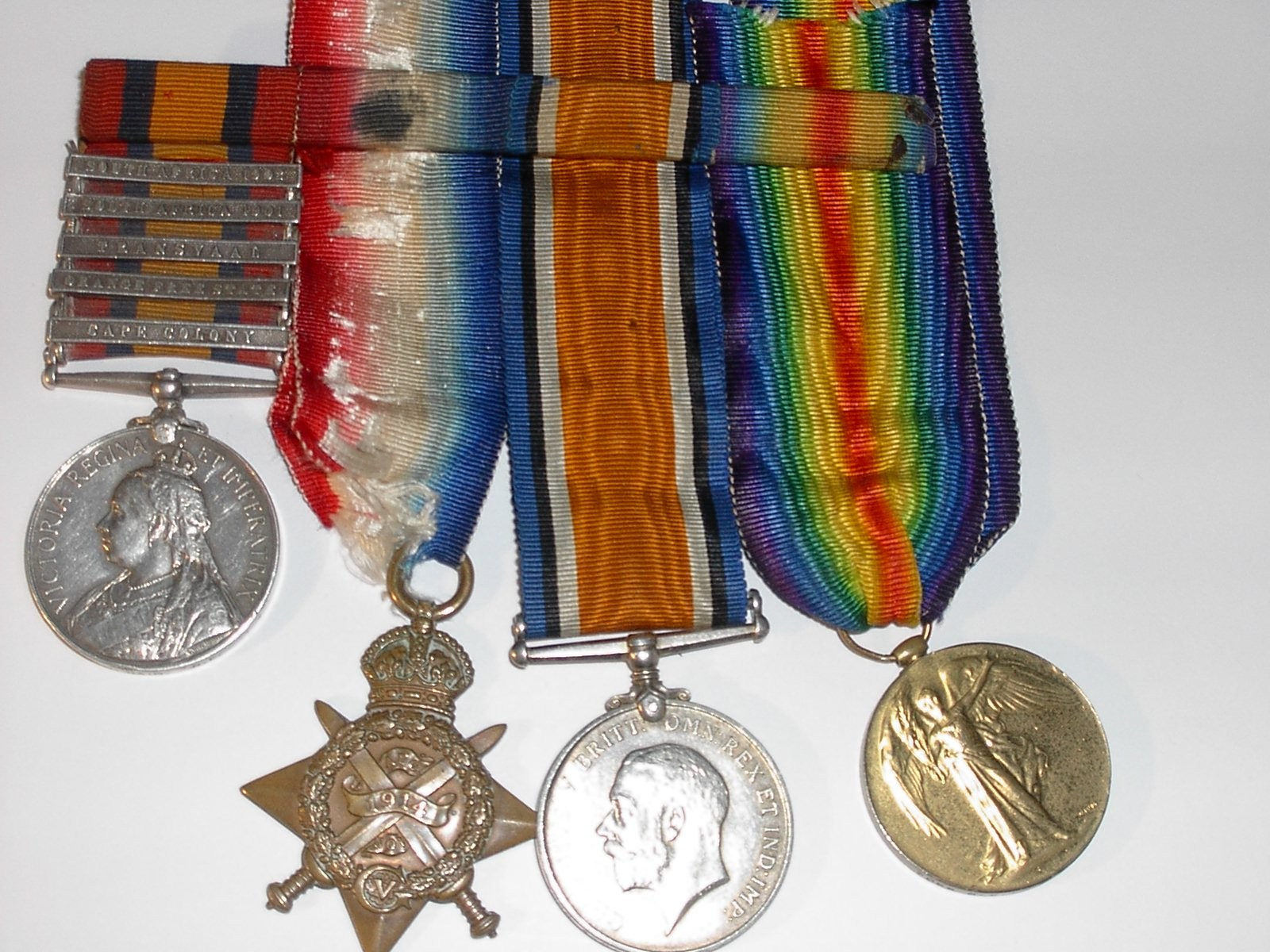
Figure 9. Hain’s Original
Medals and Ribbon Bar.
(Image courtesy of Betty Swain)
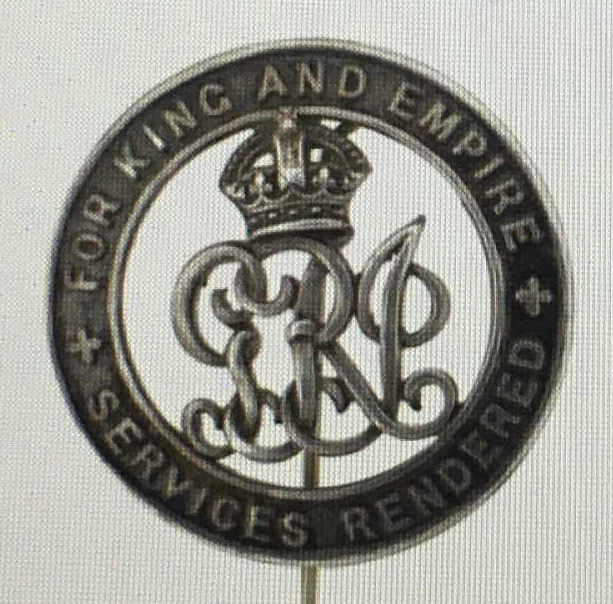
Figure
10. The Silver War Badge.[14]
Image
courtesy of Wikipedia.
As a recipient of the 1914 Star, Hain was one of the “Old Contemptibles;” that is, one of the men who served in the original units of the British Expeditionary Force.
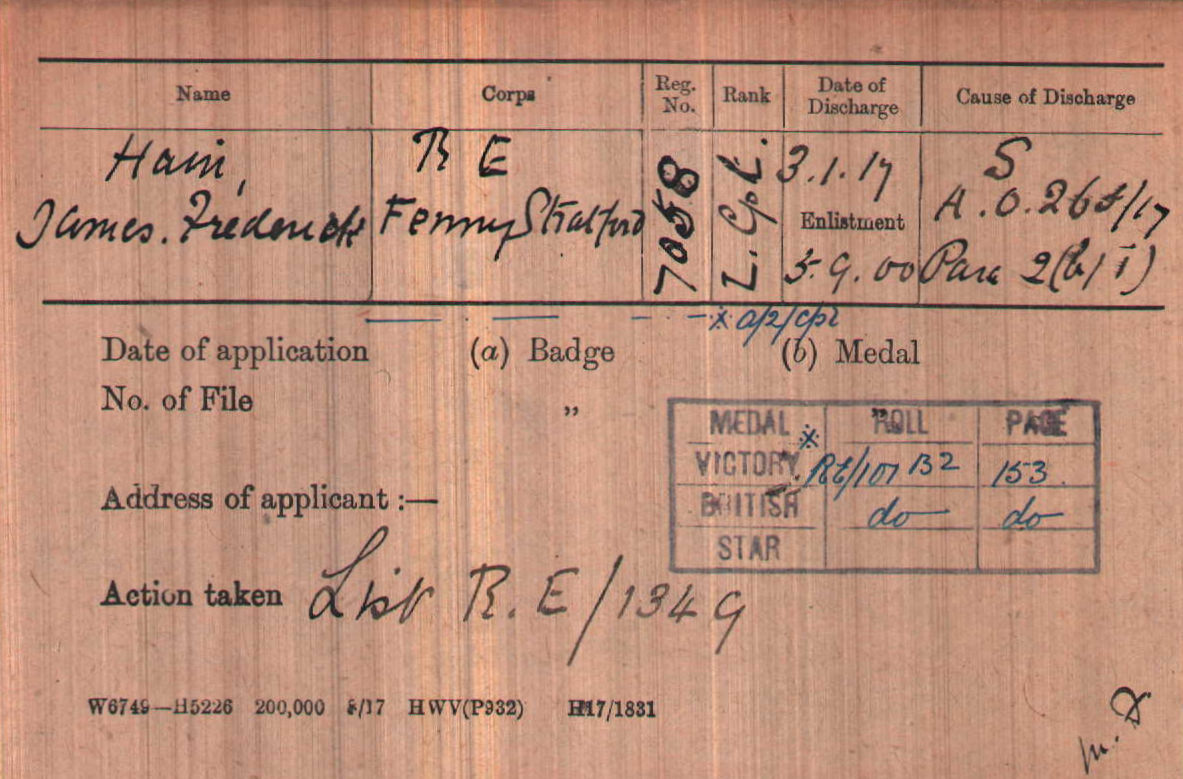
Figure
11. The Great War Medal Index Card of 7058 Lance Corporal James
Frederick Hain.
(Image courtesy of Ancestry.com)
8. RELEASE FROM SERVICE
Lance Corporal Hain was released from service on 1 April 1918. His total service, active and reserve, was reckoned as shown in the tables below:
Location |
|
Home Service (Reading, Chatham and Aldershot) |
5 September 1900 – 15 November 1901 |
South Africa |
16 November 1901 – 31 October 1902 |
Home Service (Chatham and Limerick) |
1 November 1902 – 4 September 1908 |
Army Reserve (Section A and Section B) |
5 September 1908 – 12 September 1910 |
Home Service (Annual training) |
13 September 1910 – 27 September 1910 |
Army Reserve (Section B) |
28 September 1910 – 4 September 1912 |
Re-enlisted: Section D, Army Reserve |
7 October 1912 – 4 August 1914 |
France |
5 August 1914 – 13 December 1916 |
Class W Army Reserve |
14 December 1916 – 1 April 1918 |
Location |
|
Home Service |
1 year, 1 month and 3 days |
Service Abroad |
1 year 3 months and 26 days |
Total Service (Active) |
2 years, 4 months and 29 days |
Total Service (Reserve) |
15 years and 28 days |
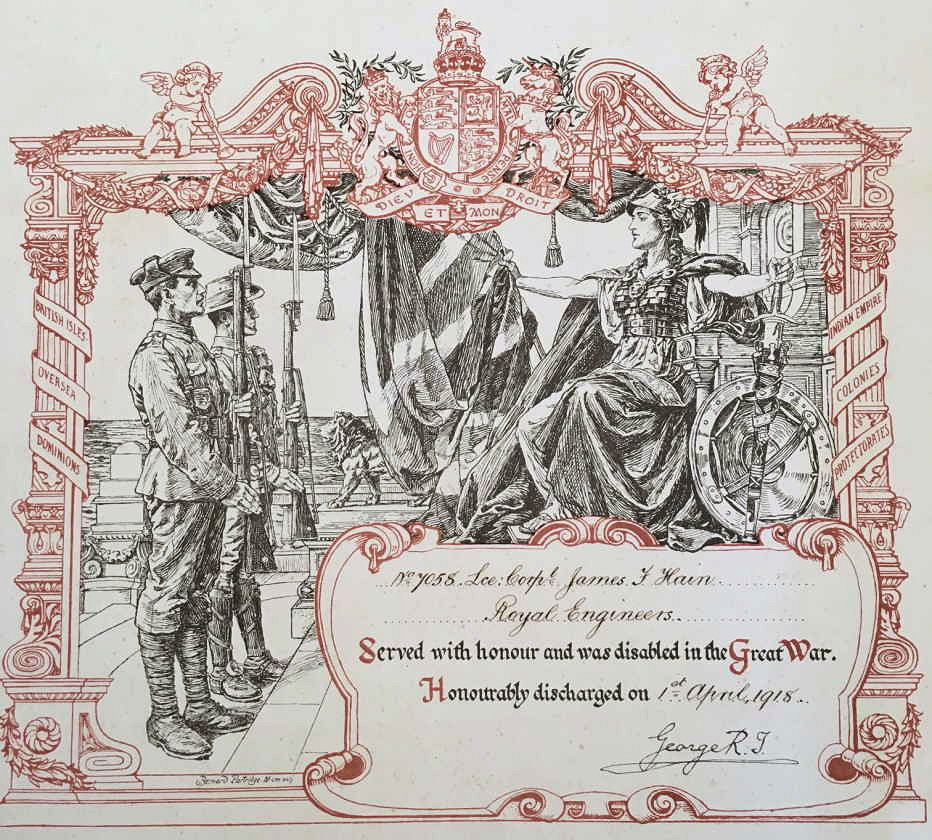
Figure
12. The Discharge Certificate of 7058 Lance Corporal James F. Hain,
R.E.
(Image courtesy of Betty Swain)
Marriage
James Frederick Hain married Beatrice Opie (1890-1977) at Carmenhellis Church in Cornwall on 4 September 1917.
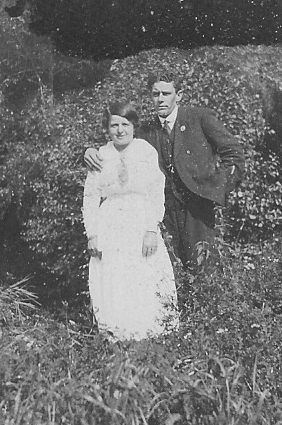
Figure
13. James Hain and Beatrice Opie, Totnes, Devon, c.
1913.
(Image courtesy of Betty Swain)
Children
James and Beatrice had a son, Frederick William Hain (1919-2000).
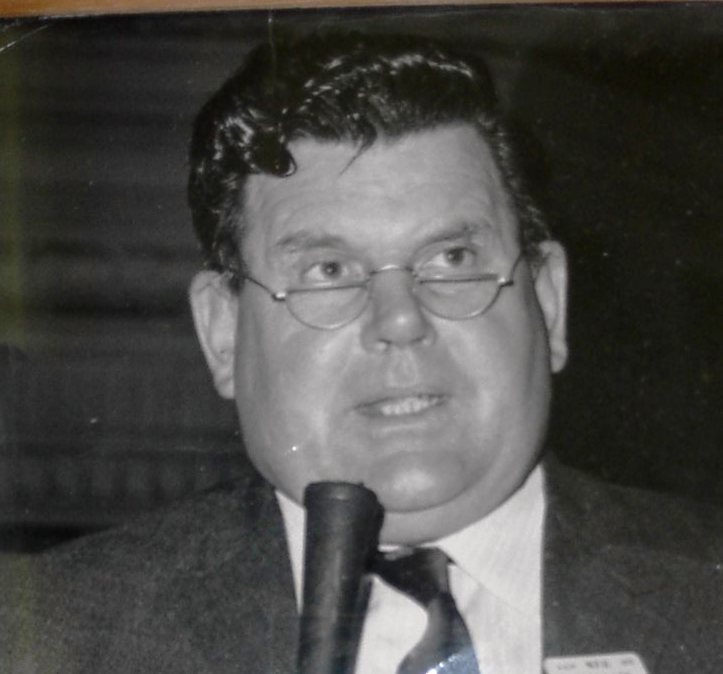
Figure
14. Frederick William Hain.
(Image courtesy of Betty
Swain)
11. POST SERVICE LIFE
Following his discharge from the Army, James returned to full-time employment with the General Post Office and in February 1920 he became a member of the Post Office Engineering Union. His residence at this time was 17 Redinnick Terrance in Penzance, Cornwall.

Figure
15. 17 Redinnick Terrace, Penzance, Cornwall.
(Image
courtesy of Betty Swain)
On 23 August 1920 Hain fell gravely ill and by 23 November 1920 he was on “Special Leave with Pay” from his job with the GPO. The number of days of illness that he experienced continued to increase each year from the time of his discharge from the Army, so that in 1918 he lost 19 days, in 1919 he lost 45 days and in 1920 he lost 55 days. In the first five months of 1921 he would lose 133 days of work, more than four months. As a result, on 13 May 1921 he was awarded a pension from the GPO. Up to that date he had worked for the GPO for 12 years and 9 months. He had also received a War Bonus of £120, 9 shilling and 5 pence for retirement due to “ill health.”
Figure
16. The Headstone of 7058 Lance Corporal J.F. Hain, R.E. His condition deteriorated rapidly so that he was admitted to the Cotford Asylum in Bishops Lydeard, Taunton, Somerset where he died on 13 June 1921. The cause of his death was listed as health problems caused by shell shock during the war. James Frederick Hain was buried in St. James Cemetery in Taunton Deane Borough, Grave No. 13, Row 10, Section 1, Division C. Probate of James Hain’s Will took place at Bodmin, Cornwall on 21 September 1921. The 1921 Probate Calendar indicated that he had been a Cornwall Post Office Engineer in Farmers Common, Wendron, Cornwall. His effects of £166, 5 shillings and 11 pence (about $13,000 US in 2023 currency) was left to his widow.
|
|
ANNEX A
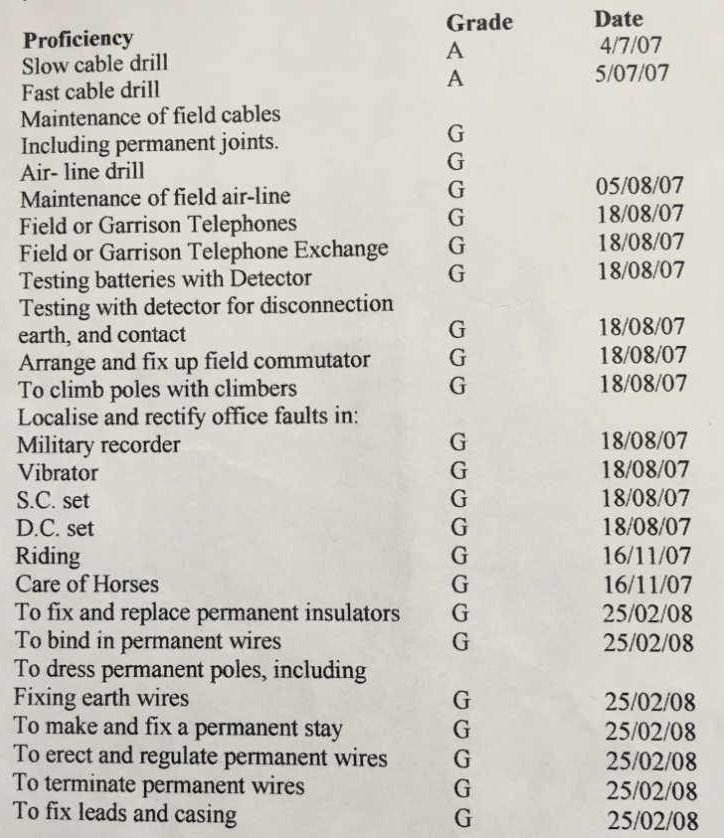
Figure 17. Trade
Proficiency Examination Results for Sapper James Frederick Hain,
R.E.
(Image corrections of Betty Swain)
REFERENCES:
Books
Watson, Charles M. (I.R.E.) The History of the Corps of Royal Engineers, Volume III, The Institution of Royal Engineers, Chatham, Kent, 1954.
Medal Roll for the Queen’s and King’s South Africa Medal (1899-1902). The Institution of Royal Engineers, Chatham, Kent, undated.
Census
1891 Census of England.
1901 Census of England (Aldershot, Stanhope and Wellington Lines).
1911 Census of England and Wales.
Civil Documents
Postcard to his brother Bill from Limerick, dated 10 July 1907.
British Postal Service Appointment Books, 1737-1969.
Probate Calendar, 1921, p. 7.
Family Trees
James Frederick Hain (1881-1921) by (bettyswain168).
Internet Web Sites
The Long, Long Trail: Classes P and T of the Army Reserve.
The Long, Long Trail: Class W and W (T) Army Reserve.
The Long, Long Trail: British Army Reserves and Reservists.
The Long, Long Trail: The British Second Army, 1914-1918.
Medal Rolls
Queen’s South Africa Medal Roll, TNA 160/15.
Queen’s South Africa Medal Roll, R.E. Medal Roll Book, 7/234.
Military Documents
Royal Engineers Medal Roll, British War Medal and Victory Medal.
Silver War Badge Roll
Periodicals
Battle Honours of the Royal Engineers. The Royal Engineers Journal. The Institution of Royal Engineers, Chatham, Kent, 1925-1932.
Service Papers
Application for Enlistment of a Recruit (Army Form B. 203).
Short Service Attestation (Army Form B. 265).
Description on Enlistment.
Statement of Services.
Military History Sheet.
Descriptive Return of a Soldier Extending Service (Army Form B. 221).
Description on Transfer to the Army Reserve.
Recommendation for Engineer Pay, 15 September 1915.
Class P Medical Board.
Report on Wounds or other Injuries except on Wounds received in Action.
Application to Transfer to Section D of the Army Reserve.
Re-Engagement Paper (Army Reserve) (Army Form D. 441).
Qualification Sheet for a Telegraphist.
Results of a Proficiency Examination.
Proceedings on Transfer to the 1st Class Army Reserve (Army Form B. 2056).
Trade and Special Qualifications.
Particulars of Service (Army Form B. 2007).
Transfer to Class W., Army Reserve, and to Class W.(T) T.F. Reserve (Army Form W. 3455.).
ENDNOTES
[1] The term 'chatoyancy', deriving from the French for 'shining like a cat's eye', denotes the effect that occurs when a bright light is shone onto a rounded, reflective surface and causes light to be reflected back in narrow line perpendicular to the observer's line of sight.
[2] Wikipedia.
[3] For some odd reason, during the Victorian period, the recruit’s religion was always included in his physical description at the time of his enlistment.
[4] Why he elected this regiment is unknown as he was a native of Hertfordshire and he was enlisting in London.
[5] Just how and why he was judged to be a “Fair” recruit is not indicated in his service papers.
[6] Hain family tree and the 1901 Census of England.
[7] His original Attestation had been for 7 years with the Colours and 5 years in the Reserve.
[8] The Long, Long Trail.
[9] Ibid.
[10] Ibid.
[11] A thorough search of this service papers did not indicate the date of his promotion; however, his discharge documents do show his rank as Lance Corporal and one document shows his rank as Acting Second Corporal.
[12] For promotion to Corporal he would have needed at least a Third Class Certificate of Education. This certificate required that he would have to be able read aloud and to write from dictation passages from an easy narrative, and to work examples in the four compound rules of arithmetic and the reduction of money. James Hain certainly could do these things, but as he never intended to make the Army his career he probably was not concerned about getting a Third Class Certificate of Education or a promotion to the rank of Corporal.
[13] Category C3 was for men free from serious organic diseases, able to stand service in garrisons at home and who could perform sedentary work.
[14] The Silver War Badge was issued in the United Kingdom and the British Empire to service personnel who had been honorably discharged due to wounds or sickness from military service in Great War of 1914-1918.